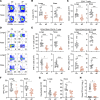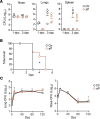Maternal acellular pertussis vaccination in mice impairs cellular immunity to Bordetella pertussis infection in offspring
- PMID: 37581930
- PMCID: PMC10561720
- DOI: 10.1172/jci.insight.167210
Maternal acellular pertussis vaccination in mice impairs cellular immunity to Bordetella pertussis infection in offspring
Abstract
Given the resurgence of pertussis, several countries have introduced maternal tetanus, diphtheria, and acellular pertussis (aP) vaccination during pregnancy to protect young infants against severe pertussis. Although protective against the disease, the effect of maternal aP vaccination on bacterial colonization of the offspring is unknown. Here, we used a mouse model to demonstrate that maternal aP immunization, either before or during pregnancy, protects pups from lung colonization by Bordetella pertussis. However, maternal aP vaccination resulted in significantly prolonged nasal carriage of B. pertussis by inhibiting the natural recruitment of IL-17-producing resident memory T cells and ensuing neutrophil influx in the nasal tissue, especially of those with proinflammatory and cytotoxic properties. Prolonged nasal carriage after aP vaccination is due to IL-4 signaling, as prolonged nasal carriage is abolished in IL-4Rα-/- mice. The effect of maternal aP vaccination can be transferred transplacentally to the offspring or via breastfeeding and is long-lasting, as it persists into adulthood. Maternal aP vaccination may, thus, augment the B. pertussis reservoir.
Keywords: Bacterial vaccines; Cellular immune response; Infectious disease; Mouse models; Vaccines.
Conflict of interest statement
Figures








Similar articles
-
Immunization with whole cell but not acellular pertussis vaccines primes CD4 TRM cells that sustain protective immunity against nasal colonization with Bordetella pertussis.Emerg Microbes Infect. 2019;8(1):169-185. doi: 10.1080/22221751.2018.1564630. Emerg Microbes Infect. 2019. PMID: 30866771 Free PMC article.
-
Impact of maternal whole-cell or acellular pertussis primary immunization on neonatal immune response.Front Immunol. 2023 Jun 26;14:1192119. doi: 10.3389/fimmu.2023.1192119. eCollection 2023. Front Immunol. 2023. PMID: 37435078 Free PMC article.
-
Quantity and Quality of Antibodies After Acellular Versus Whole-cell Pertussis Vaccines in Infants Born to Mothers Who Received Tetanus, Diphtheria, and Acellular Pertussis Vaccine During Pregnancy: A Randomized Trial.Clin Infect Dis. 2020 Jun 24;71(1):72-80. doi: 10.1093/cid/ciz778. Clin Infect Dis. 2020. PMID: 31418814 Clinical Trial.
-
Diphtheria-tetanus-acellular pertussis vaccine adsorbed (Triacelluvax; DTaP3-CB): a review of its use in the prevention of Bordetella pertussis infection.Paediatr Drugs. 2000 Mar-Apr;2(2):139-59. doi: 10.2165/00148581-200002020-00007. Paediatr Drugs. 2000. PMID: 10937466 Review.
-
The Role of Mucosal Immunity in Pertussis.Front Immunol. 2019 Jan 14;9:3068. doi: 10.3389/fimmu.2018.03068. eCollection 2018. Front Immunol. 2019. PMID: 30692990 Free PMC article. Review.
Cited by
-
Pertussis in Early Infancy: Diagnostic Challenges, Disease Burden, and Public Health Implications Amidst the 2024 Resurgence, with Emphasis on Maternal Vaccination Strategies.Vaccines (Basel). 2025 Mar 5;13(3):276. doi: 10.3390/vaccines13030276. Vaccines (Basel). 2025. PMID: 40266155 Free PMC article. Review.
-
Pertussis before, during and after Covid-19.EMBO Mol Med. 2025 Apr;17(4):594-598. doi: 10.1038/s44321-025-00199-2. Epub 2025 Feb 24. EMBO Mol Med. 2025. PMID: 39994481 Free PMC article. Review.
References
-
- Rocha G, et al. Pertussis in the newborn: certainties and uncertainties in 2014. Paediatr Respir Rev. 2015;16(2):112–118. - PubMed
Publication types
MeSH terms
Grants and funding
LinkOut - more resources
Full Text Sources
Medical

